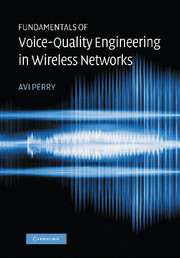Book contents
- Frontmatter
- Contents
- Preface
- List of abbreviations
- Introduction
- Part I Voice-quality foundations
- Part II Applications
- Part III Wireless architectures
- 7 Mobile-to-mobile stand-alone VQS architectures and their implications for data communications
- 8 The VQS evolution to 3G
- Part IV A network operator's guide for selecting, appraising, and testing a VQS
- Part V Managing the network
- Part VI Afterthoughts and some fresh ideas
- Part VII Recordings
- Glossary of common voice-quality systems terminology
- Brief summary of echo cancelation and VQS major standards
- Brief summary of key voice-quality assessment standards
- Bibliography
- Index
- Frontmatter
- Contents
- Preface
- List of abbreviations
- Introduction
- Part I Voice-quality foundations
- Part II Applications
- Part III Wireless architectures
- 7 Mobile-to-mobile stand-alone VQS architectures and their implications for data communications
- 8 The VQS evolution to 3G
- Part IV A network operator's guide for selecting, appraising, and testing a VQS
- Part V Managing the network
- Part VI Afterthoughts and some fresh ideas
- Part VII Recordings
- Glossary of common voice-quality systems terminology
- Brief summary of echo cancelation and VQS major standards
- Brief summary of key voice-quality assessment standards
- Bibliography
- Index
Summary
Introduction
This chapter portrays the 2G, and 3G network topologies, and their impact on VQA feasibility and architecture. It provides an evolutionary examination of the process leading from the 2G to 3G wireless architecture, and it presents a parallel progression of placement and applicability of the VQS that supports the evolving infrastructure.
3G promotions and promises
Anyone following the latest developments in wireless telecommunications has certainly noticed the hype concerning the 3G wireless era. “It sets in motion high-speed web-cruising via your cellphone,” the exuberant technologists exclaim. “It lets you watch a movie on your cellphone,” the ecstatic entrepreneurs predict, waiting for you to part your lips in awe. “It represents an amazing political transformation,” the sociological gurus gasp. “Imagine – a single standard, with the GSM and TDMA (IS-54) advocates surrendering to a competing religion – CDMA,” the 3G zealots chant in unison. Although these are exciting and enticing statements, they represent rumour and, at best, are actually only half-truths.
Considering the complexities, it may take quite some time beyond launching the early pieces of 3G networks for wireless-data rates to match existing wireline digital subscriber line (DSL) and cable-modem speeds. Presently, the 3G theoretical speed limits are severely constrained by implementation intricacies.
The 3G IMT-2000, UMTS, and cdma2000 capabilities are founded on the basis of foresight and planned service capabilities that require wide-band virtual channels, which enable full-motion video transmission and very high-speed data-transfer options.
Information
- Type
- Chapter
- Information
- Fundamentals of Voice-Quality Engineering in Wireless Networks , pp. 163 - 172Publisher: Cambridge University PressPrint publication year: 2006
